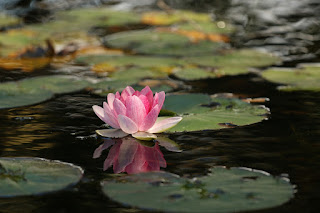Exploring the Third Jhana: Embracing Contentment and Equanimity
My Journey into the Third Jhana

As I’ve progressed through my meditation practice, each Jhana has offered me something different—new layers of understanding, deeper levels of calm, and a closer connection to the present moment. When I reached the Third Jhana, it felt like I was stepping into an entirely new phase of inner peace and balance. The joy and excitement of the earlier stages, particularly the First and Second Jhanas, were no longer the main focus. Instead, I found myself embracing a quiet, deep sense of contentment and equanimity. If you haven’t checked out the first and second Jhanas start there first!
For me, this stage was less about the external sensations or even the initial bursts of joy that meditation can bring, and more about finding a solid, peaceful ground within. It wasn’t an immediate shift—it took time to let go of the subtle craving for that more intense happiness, to simply sit in the calmness that naturally emerged. But when I allowed myself to surrender to this calm, I realized the Third Jhana was about true, lasting tranquility.
In this article, I’ll share what this phase of my meditation journey has meant to me. I’ll explore how the Third Jhanaintroduced me to a more profound sense of inner balance, and how learning to embrace this state has helped me bring more contentment and equanimity into my everyday life.
Letting Go of Joy to Embrace Contentment
One of the most significant shifts I noticed moving from the Second Jhana to the Third was the transition from joy to contentment. In the earlier stages of meditation, I found immense joy and rapture—a sense of exhilaration that felt almost euphoric. But as I moved deeper, I realized that holding onto that joy could become an obstacle. I began to understand that the joy I had experienced, while beautiful, was a temporary state, something my mind still wanted to cling to.
Letting go of that joy wasn’t easy. I had to remind myself that this wasn’t about chasing feelings or recreating the previous experiences. Instead, it was about learning to sit with whatever arose in the moment, without craving or attachment. In the Third Jhana, joy dissolves into a quiet, more subtle form of happiness—something calmer, more sustainable. It’s a shift from the active, vibrant happiness of the first stages to something that feels more like contentment—a deep satisfaction that doesn’t depend on external circumstances.
This was a turning point for me. By letting go of the need for joy, I discovered a profound sense of peace that was far more grounding. It wasn’t flashy or overwhelming, but it was steady. And that steadiness gave me something even more valuable: the ability to remain balanced and content, no matter what was happening around me.
This shift in focus helped me appreciate that contentment—not just fleeting happiness—was the real treasure of the Third Jhana. It taught me that true inner peace comes from accepting what is, rather than constantly seeking out something more.
Experiencing Deep Equanimity
As I settled into the Third Jhana, I encountered a new depth of equanimity that I hadn’t fully experienced before. Equanimity, for me, is the ability to remain centered and at peace, regardless of external conditions or internal fluctuations. In this state, everything seemed to balance out—the highs and the lows, the joy and the pain, even the stillness and the subtle thoughts that still occasionally arose.
I realized that equanimity wasn’t about numbing myself to emotions or avoiding challenges, but about observing everything with a calm, balanced mind. It’s as if the turbulence that once stirred me during meditation had settled, and what remained was an unwavering stillness. Thoughts might arise, emotions might come and go, but there was a space in me that remained untouched—calm, steady, and serene.
This profound sense of equanimity helped me understand the true essence of meditation. It’s not about escaping the world or living in a bubble of tranquility. Instead, it’s about developing the ability to face life with an open heart, no matter the circumstances. In the Third Jhana, the peace I felt was not because life had become easier or less complex. It was because I had begun to cultivate a mind that could stay composed and unshaken, even amid uncertainty.
Equanimity, I found, isn’t just for the meditation cushion. The more I practiced, the more I noticed this sense of balance seeping into my everyday life. Whether dealing with small frustrations or larger life challenges, I felt more grounded, more resilient. The gift of the Third Jhana was this deeper understanding of equanimity—one that not only transformed my meditation practice but also how I engaged with the world.
The Subtle Joy of Contentment in the Third Jhana
The Third Jhana is often described as a state of serene contentment, where the intense rapture of the earlier Jhanas gives way to a more refined, subtle joy. When I first experienced this shift, it was surprising. The excitement and thrill I had initially felt in the earlier stages of meditation softened into something much quieter, yet equally profound.
In this state, I realized that joy doesn’t always need to be exuberant or overwhelming. The contentment I felt in the Third Jhana was gentle and unshakable, a kind of happiness that wasn’t reliant on any external factors or fleeting emotions. It was a joy that came from simply being present, a deep satisfaction with the moment exactly as it was.
This shift in my meditation practice mirrored a change in how I began to experience life. I no longer felt the need to chase after moments of intense happiness or excitement. Instead, I found myself appreciating the calm, quieter joys that are often overlooked—the warmth of sunlight on my skin, the sound of wind rustling through trees, or the stillness of a peaceful morning. These simple moments became more meaningful, as I carried the contentment of the Third Jhana into my everyday life.
This state of contentment also taught me the power of acceptance. In the Third Jhana, there’s no longer any desire to control or manipulate the experience. Everything feels perfect just as it is. This level of acceptance transformed how I approached my meditation practice and my daily experiences. Rather than resisting discomfort or striving for something different, I learned to rest in the simplicity of the present moment. This contentment was liberating, allowing me to let go of the need for more and simply embrace the beauty of what already is.
Equanimity—The Profound Peace of the Third Jhana
As I deepened my practice into the Third Jhana, I encountered the transformative quality of equanimity. This profound peace is perhaps the most significant hallmark of the third state of deep meditation. It represents a balance and detachment from the dualities that typically sway our emotions and reactions.
Equanimity in the Third Jhana feels like being at the center of a storm but completely untouched by the chaos around. It’s a state where neither pleasure nor pain, gain nor loss, nor fame nor disgrace affects the mind’s deep, abiding tranquility. This was a radical shift from the fluctuating states of happiness and distress I was accustomed to in daily life.
This newfound equanimity had a profound effect on how I interacted with the world. Situations that would have previously triggered a strong emotional response now met with a calm, measured approach. It wasn’t that I didn’t care or feel; rather, I experienced everything more fully and less reactively. This balance allowed me to make decisions from a place of clarity and compassion, rather than being driven by immediate emotional impulses.
The peace of equanimity also spilled over into my relationships, enabling me to offer a greater presence and understanding. I found myself better equipped to listen without judgment and respond without urgency. This was not a detachment from others, but an enhanced connection, free from the usual projections and expectations that can cloud interactions.
In embracing equanimity, I discovered a profound truth about inner peace: it does not mean removing oneself from the world, but rather engaging with it more completely, yet from a place of balanced calm.
The Subtle Joy of Contentment in the Third Jhana
One of the most beautiful aspects of the Third Jhana is the subtle joy that comes from deep contentment. Unlike the more exuberant joy found in the earlier stages of meditation, the joy of the Third Jhana is quieter, more refined, and rooted in a profound sense of inner fulfillment.
At this stage, I found myself no longer seeking external stimuli or validation for happiness. The contentment I experienced came from within, and it was incredibly liberating. This joy wasn’t tied to any specific object or outcome; it was simply a byproduct of being fully present in the moment, without attachment or aversion.
This contentment brought a sense of ease that permeated every aspect of my life. I no longer felt the need to chase after fleeting pleasures or avoid discomfort. Instead, I could sit comfortably with whatever arose, knowing that the true source of joy was always available within me. This realization was transformative—it allowed me to let go of the constant striving that had been a part of my life for so long.
The subtle joy of the Third Jhana also deepened my connection to gratitude. As I sat in meditation, I began to appreciate the simple things—the sensation of my breath, the stillness of my mind, and the profound peace that came with letting go. This gratitude extended beyond my meditation practice and into my everyday life, helping me to find joy in the smallest of moments.
In embracing this contentment, I learned that happiness doesn’t come from achieving more or acquiring new things. It comes from within, from cultivating a peaceful and content mind. This was a powerful lesson that has continued to shape my life and practice.
Embracing Equanimity in the Third Jhana
The final and perhaps most profound shift in the Third Jhana is the cultivation of equanimity—a state of mental calmness, composure, and even-mindedness, especially in difficult situations. In this stage, joy gives way to an even deeper serenity, one that is not easily disturbed by external events or internal fluctuations.
Equanimity in the Third Jhana isn’t about indifference or detachment in the way we often think of it. Rather, it’s about finding peace in the midst of life’s changes and challenges, recognizing that all experiences—whether joyful or painful—are temporary. This understanding brought me a sense of profound liberation.
As I continued to deepen my practice, I noticed that my reactions to everyday irritations and stressors began to change. Things that once triggered frustration or anxiety had less power over me. Equanimity allowed me to respond to life’s ups and downs with a calm mind and an open heart, rather than reacting impulsively or emotionally.
I found that this shift extended far beyond my meditation cushion. In moments of stress or uncertainty, I could anchor myself in the peace cultivated during my meditations, allowing me to maintain clarity and balance. This newfound equanimity has been invaluable in my relationships, work, and personal life, as it helps me stay grounded and present, even in challenging times.
In the Third Jhana, equanimity is not the absence of emotion, but rather the ability to experience all emotions without being consumed by them. This was a crucial turning point for me. Instead of avoiding difficult feelings or clinging to pleasant ones, I could let all experiences flow through me without attachment. This freedom from attachment is what allows the mind to rest in a deep and abiding peace.
Through embracing equanimity, I came to realize that the ultimate goal of meditation isn’t just about finding joy or happiness—it’s about developing a steady, peaceful mind that remains balanced regardless of the external circumstances. This realization was one of the most rewarding aspects of my journey through the Third Jhana, and it has continued to shape my approach to meditation and life.
Resources for Deepening Your Meditation Practice with the Jhanas
- Entering the Formless Jhanas: My First Steps into Infinite Space
Read the full article - Common Pitfalls and Misconceptions About the Jhanas: What I’ve Learned
Explore insights - Achieving Equanimity in the Fourth Jhana: My Experience
Discover more - Meditation and Creativity: 10 Techniques to Unlock Your Creative Potential
Learn techniques - Reflection on My Jhana Journey: Integrating Meditation Insights
Read reflections - How the Jhanas Have Transformed My Spiritual Path
Explore transformation - Applying Jhana Meditation Insights to Everyday Life
Apply insights - My Journey into the Third Jhana
Read about the third Jhana - The Journey to the Second Jhana
Explore the second Jhana - Finding Joy and Tranquility in the First Jhana: Personal Reflections
Discover joy and tranquility







